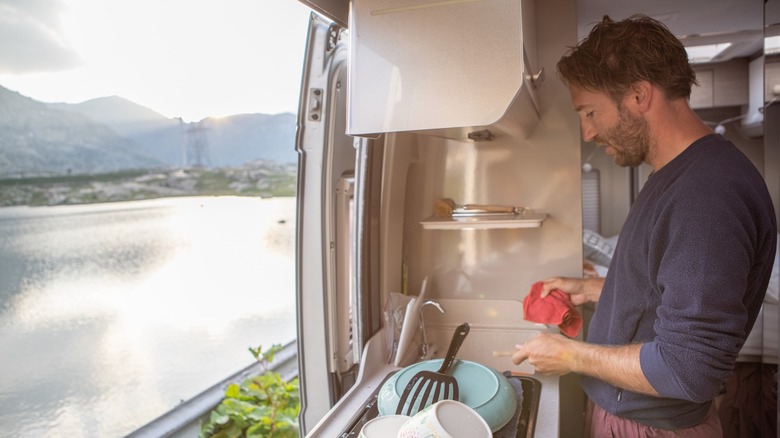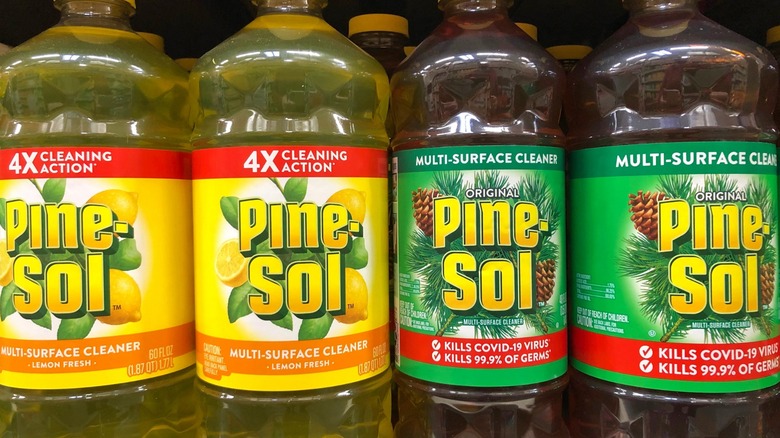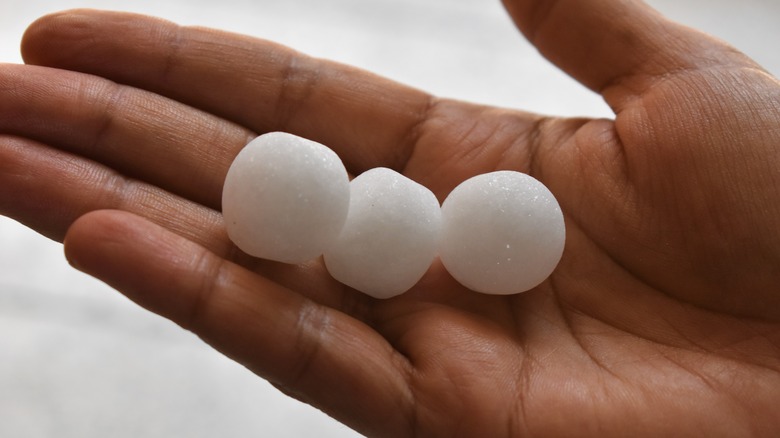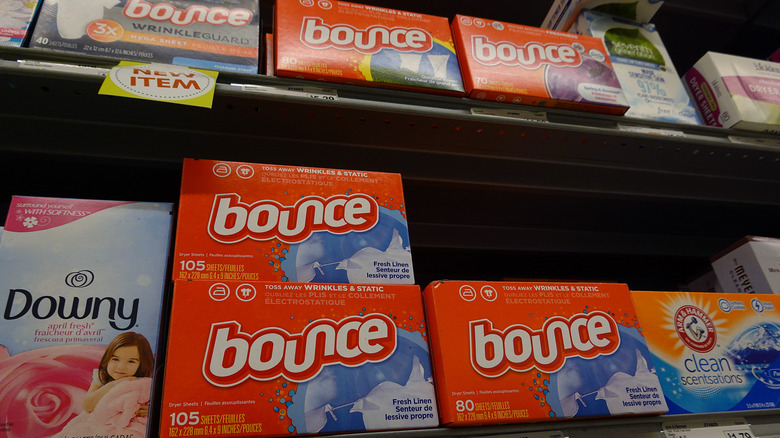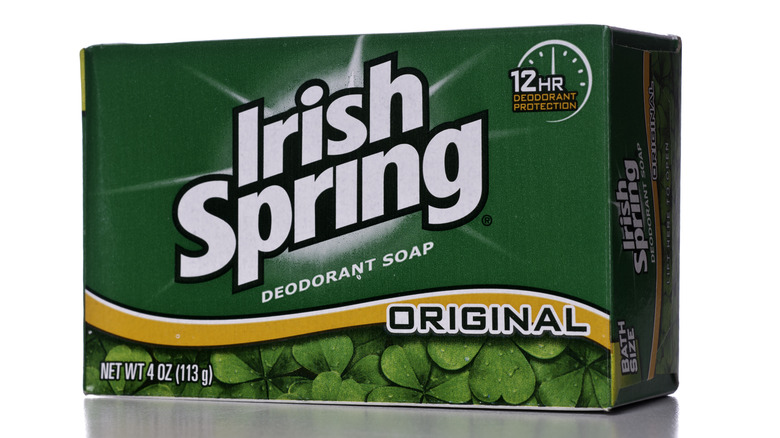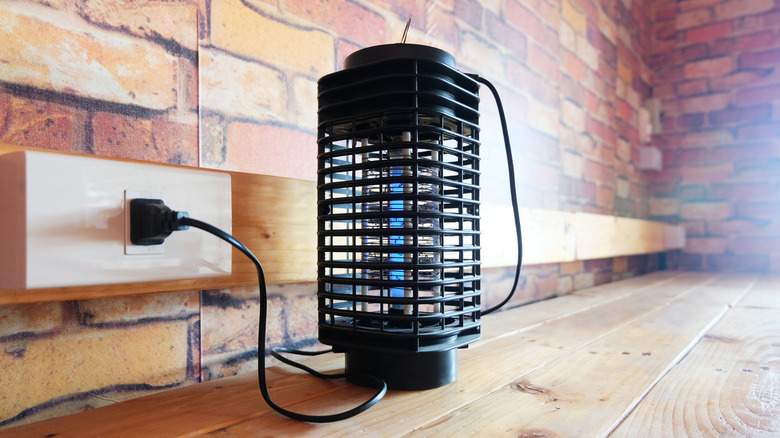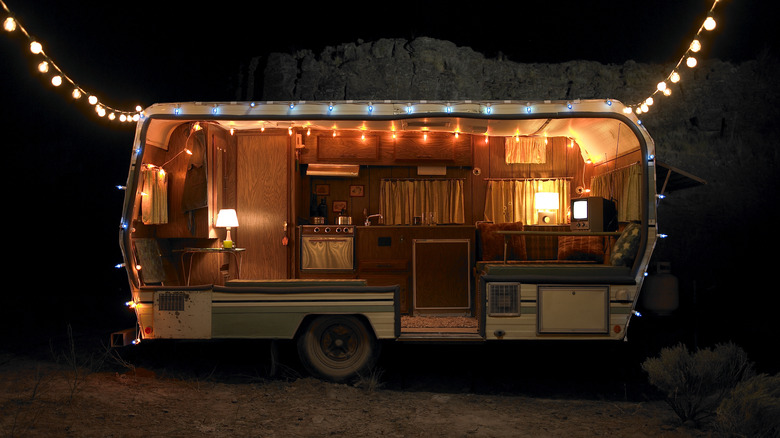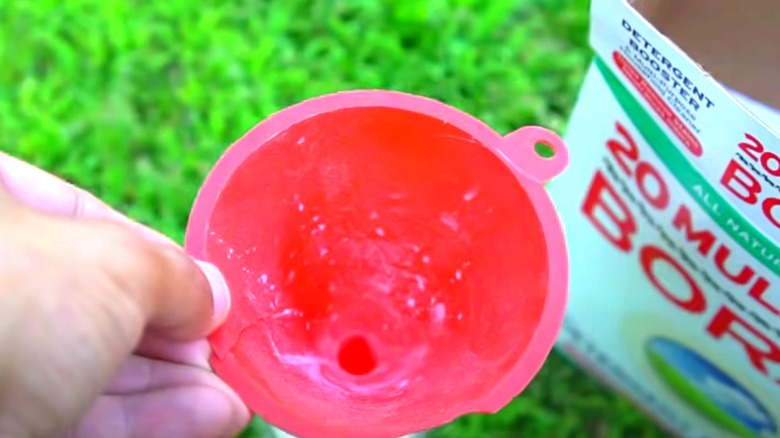Keep Bugs Out Of Your RV With These Simple Tips
For those of us who love traveling the country and spending time in the great American outdoors but also value our creature comforts, nothing beats the pure joy of RV camping. Whether we're cruising the highway or taking an extended stay at one of the best U.S. national parks, RV life offers freedom, comfort, and glamping on the go. But in the summer heat, RVing can also offer a few things we didn't bargain for — fruit flies, mosquitoes, and ants. Part of RV life's appeal is the chance to experience the great outdoors without the ick factor, and few things can drag down the fun faster than a bug infestation.
Fortunately, most RV bug problems don't require taking drastic measures to resolve them. Like everything else we do on the road, all it takes is a little planning to keep things running smoothly, so you can focus on the important details like which beach you're heading to next. Follow this guide to keep your bug problems to a minimum on your next RV outing.
Store your food wisely
Storing your food the right way is essential to keeping bugs out of your RV. Don't make the mistake of simply stocking your food on your RV shelves where it might become a smorgasbord for creepy crawly stowaways. Stashing all of your dry goods in the RV pantry leaves them susceptible to bug infestations, mold, and perhaps worst of all, mice. Instead of loading up your rig with groceries, it's a good idea to organize your RV refrigerator and pantry with only what you'll need on hand. Pack anything you aren't using in airtight storage totes to be stored in a cool, dry place inside of your RV. Bring along a set of smaller, high-quality airtight plastic containers for storing your open bags of snacks. Most importantly, make sure everyone in your crew is on board about how important it is to keep everything sealed.
When it comes to keeping your rig free of uninvited guests, the work doesn't end when you arrive back home. While it's tempting after a long trip to unpack and leave the cleaning for later, it can be easy to overlook a forgotten bag of chips or ketchup packets. Detailing your RV before packing it up for the season, ensuring you're not leaving out any food, is the best way to prevent tagalongs when you're ready to head out again.
Keep your RV clean
There's nothing quite like the energy and excitement of stepping into your freshly packed RV ahead of an upcoming trip, with everything tucked away neatly in its place. But depending on the size and age of your crew, it only takes an afternoon on the road for things to start to get a little chaotic. Keeping your space clean is essential for preventing bugs from taking up residence in your space. Between all of the gas station stops and roadside attractions, your RV floor can pick up a lot of dirt throughout the day. You're also eating, sleeping, and hanging out in that space — all of which can contribute to a messy floor.
To keep your floor clean, use a handheld vacuum cleaner or broom to sweep at least once a day, if not more frequently. Keep plenty of disinfectant wipes on hand to wipe down all of the surfaces in your RV, and don't forget to wipe out the cupholders. Resist the temptation to let your dishes pile up (even for a little while), as it won't take long before dirty dishes begin to attract ants and/or fruit flies. Instead, make a habit of washing up after every meal. Dealing with trash can be especially tricky in an RV — you'll need to store your waste inside sealed waste containers and empty them regularly.
Use Pine-Sol to clean
Pine-Sol was first sold in 1929, and the original formula contained pine oil, a natural repellant for flies and other insects. Although pine oil is no longer part of the formula, many longtime users still swear by Pine-Sol's insect-repellent properties due to its potent pine odor, particularly against flies, ants, and mosquitos. It's also one of the safer cleaning products on the market today, which means you won't have to worry about exposing your pets or children to the odor in the small space of your RV. You can use Pine-Sol to wipe down most of the surfaces in your RV including plastic, linoleum, hardwood, glass, ceramic tile, and carpet. It can also be diluted for disinfecting purposes or even added to your laundry.
Seasoned users recommend a few other approaches for warding off bugs with Pine-Sol. Soak a few cotton balls in the cleaner, and then strategically place them where flies or ants tend to swarm. Spray down your camp furniture with a diluted formula each time you set up camp to minimize the chance you'll end up fighting ants while you relax at the end of a long day. And don't forget to wipe out your waste bin with Pine-Sol before adding a new trash liner. Not only will these methods help repel bugs — but your RV will continue to smell fresh.
Use moth balls
Mothballs are one of those tried-and-true, old-school methods that always seem to get the job done, and it turns out they work just as well for an RV as they do in your coat closet. If you're not familiar with the mini-bug busters, mothballs are small, round balls containing deodorant and a chemical pesticide called naphthalene that vaporizes when exposed to room temperature. Even if you've never used them personally, there's a good chance you've encountered the camphor-esque smell of mothballs in an older home or supply closet.
Mothballs are typically used to repel moths and moth larvae as the insects love snacking away on our clothing. As it turns out, mothballs are also quite effective at repelling other types of fiber pests like silverfish, which also like to take up residence in campers. When using mothballs in your camper, it's important to use them safely. Remember, they do contain a pesticide that's harmful to humans and our furry friends, and if you can smell mothballs in the air, you're risking exposure to the toxic chemicals inside of them. Follow the label carefully, using them only in tightly closed containers with your clothing. And always keep mothballs out of reach of children and pets.
Dryer sheets work wonders
Kitchen wisdom has long claimed that dryer sheets repel bugs. According to one old wive's tale, a fabric softener sheet in your pocket can even reduce mosquito bites when you're working in the garden. For years, those claims were mainly anecdotal, but they're grounded in some very real science.
Most fabric softeners contain two key ingredients known to have detrimental effects on some bugs: linalool and beta-citronellol. Naturally occurring in herbs like basil and lavender, sweet-smelling linalool is widely used for commercial applications, from perfumes to traditional medicines. A key ingredient in many fabric softeners, linalool is known to be toxic to a number of mite species and other insects, causing many experts to speculate they could have a repellant property to some types of bugs. Chemically, it is classified as a natural insecticide due to its neurotoxic properties and can sometimes be found in flea treatments. Its sister compound, beta-citronellol, is the key ingredient in citronella, a known mosquito repellent. A 2010 study found Bounce dryer sheets repelled fungus gnats, providing further evidence for the bug-banishing value of fabric softener sheets.
The great news about dryer sheets is they're small enough to be placed almost anywhere and will leave your RV smelling great. Try placing them in your luggage, drawers, and cabinets — and don't forget to stick one in your pocket before heading outside.
Try essential oils and herbal repellents
The internet is full of essential oil claims that don't live up to the hype. But when it comes to repelling bugs and pests, there are a number of essential oils and other natural remedies that evidence-based research can get behind. A 2022 study in Malaria Journal found both eastern red cedar oil and rose geranium oil were highly effective at killing mosquitos throughout their life cycle. And, according to the USDA, cedarwood oil is safe for humans but seriously toxic to a number of pests, including houseflies and several species of ticks and mosquitoes. Another study found the essential oils of eucalyptus, thyme, rosemary, and lavender were effective repellents against the northern house mosquito.
An easy way to use essential oils around your RV is to apply the oils to cotton balls and leave them on window sills and other strategic locations. Create a solution to treat different spaces within and around your RV using ¼ cup witch hazel, ¼ cup distilled water, and 20-30 drops of your chosen essential oil or any combination thereof. Throw in a teaspoon of vegetable glycerin, and you'll soon have a pleasant-smelling natural skeeter repellent. You can also burn herbs on your campfire to banish bugs.
Apple cider vinegar makes an effective gnat trap
Another popular kitchen cabinet insect remedy that's anecdotally touted as a mosquito repellent is apple cider vinegar (ACV), but don't go spraying it all over your RV unless you want to trade your bug bites for a serious fruit fly problem. Although the crunchier corners of the internet are brimming with claims that ACV is an effective mosquito repellent, researchers often use it to attract flies for use in scientific studies, with one study by the Instituto de Ecología AC describing ACV as "remarkably attractive" to a particular species of fruit fly.
The good news is that all those researchers are actually onto something. Apple cider vinegar can make an effective trap for gnats and fruit flies, both of which can be a hard-to-get-rid-of kitchen pest once they move into your RV. Since these tiny bugs go absolutely bonkers for ACV, the pungent vinegar is the perfect bait for the little pests. After you set up camp, simply pour some ACV into the bottom of any wide-mouthed container, then add a few drops of dish liquid to coat their wings when they fly in for a tasty treat. Rubber-band some plastic wrap over the top, poking a few holes for one-way entry. You'll be surprised at how many bugs you catch!
Reach for the soap
No list of ways to keep insects out of your rig would be complete without including a requisite TikTok road trip hack. And one of TikTok's favorite home hacks involves using Irish Spring to repel bugs and rodents. The hack involves rubbing a bar of Irish Spring around the frames of exterior doors and windows to repel bugs. Unfortunately, the hype is just that, and we'll help debunk this viral advice. According to KHOU 11, Colgate-Palmolive's official statement on the matter insisted the product was never tested on insects, and on the news report, Texas A&M entomologist Molly Keck emphasized she knew of no scientific reason the trend should work. But, as it turns out, there are effective ways to use soap to kill bugs around your RV.
Many insects become immobilized in soapy water. To boot, some soaps can be toxic to plant-eating insects' nervous systems, while others have the ability to wash away the protective coating that keeps an insect from drying up and dying. To try it out on the flies around your campsite or rig, simply dilute your favorite hand soap or liquid dish soap in a spray bottle to keep around your RV. When flies start to swarm, reach for the spray bottle and let the soap work its insecticidal magic. Or let the bubbles slow them down before taking aim with your flyswatter.
Invest in a tabletop bug zapper
While we love an all-natural, low-tech hack as much as the next guy, there's something to be said for the effectiveness of a good old-fashioned bug zapper. These days, the market is flooded with portable bug zappers that sit right on your table and are every bit as effective as the Ole' Sparky lighting up your home porch every summer. Small and handy, these portable electric zappers can be charged via USB cable and come in a wide selection of sizes and styles.
Portable bug zappers are best used inside your RV near the kitchen area where pests can interfere with your meal preparation and dinner. In an investigation consulting several experts including an entomologist and neurobiologist, The New York Times' Wirecutter found that when used outdoors, bug zappers have a potentially harmful effect on ecosystems and aren't always particularly effective in killing the bugs they're intended to target. But they could be an effective solution when you've got a bug or two buzzing around inside of your RV.
Replace your lights
Some bugs just can't help themselves. They tend to go absolutely bonkers when they see a bright, shiny light. It's a fact that leads to endless frustration when camping, but it can be even more of a drag when your RV is the only source of light around. And few things in life are more disgusting than inhaling a mouthful of gnats as you walk past the RV porch light on a hot summer night. Since you most likely need that light to get around your RV safely — not to mention see anything — you can't exactly keep it off, either.
To this day, entomologists aren't entirely sure why some bugs are drawn to light, a proclivity known as phototaxis. However, scientists have discovered that phototactic insects are most drawn to heat-generated light, broad-spectrum incandescent light, and light in the blue and ultraviolet spectrum. RV travelers can leverage this fact to their advantage by investing in lights that output wavelengths bugs don't like. Since cool-white and warm-white LED lights don't put off very much UV light, replacing your porch light and the lights inside your RV will likely dramatically cut down on your bug problem.
Use window fly traps
RV parks seem to be magnets for flies. It's like Black Fly Burning Man — it seems like every time the door opens, a few more come in, and they're bringing their friends to the party. While the last thing you need on your dream vacation is a camper full of big, nasty biting flies buzzing around, the idea of filling up your space with ugly strips of fly tape doesn't seem much better. Fortunately, there are a number of handy solutions that work on the same principle as fly paper and are much better suited to RV living.
You can order segments of adhesive paper (the classier cousin of flypaper) that stick to your window, which is perfect because that's where flies love to hang out. They're easy to apply and just as easy to take off. More importantly, flies that land on them don't stand a chance. These traps are also effective against a few other buggy nuisances like fruit flies, gnats, and Asian seed beetles.
Make your own ant killer
Ants are a common frustration for RV campers. The best way to keep them out of your rig is to make sure they don't have any points of entry. Check around your windows and doors to ensure they are well-sealed. But, if you find yourself dealing with an ant problem, you can easily throw together a fairly effective homemade ant repellent. Kitchen wisdom suggests a number of spices are effective for keeping ants at bay, a claim supported by an Old Dominion University study that found Ngo Hiang Spice Mix (anise, galangal, cinnamon, and star anise), turmeric, and cinnamon all seemed to repel ants. With that said, if the idea of spreading spices across your windows and door frames to gently nudge ants away lacks appeal, making a DIY Borax repellent can get rid of them for good.
A type of salt that's commonly used in cleaning, Borax is highly toxic to ants. The tricky part is convincing them to eat it, an obstacle you need sugar to overcome. Thoroughly dissolve ½ cup of sugar and 1½ tablespoons of Borax in 1½ cups of warm water, then soak cotton balls in the solution. Making sure no pets or children can get ahold of them, deposit your cotton balls along your ant path. Drawn to the sugar, the ants will ingest the Borax and die, but not before bringing it back to their colony where it will take out their friends.


